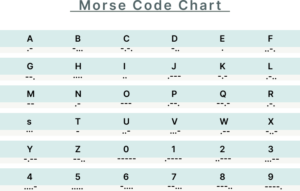Morse Code is a communication method that uses a combination of dots, dashes, and spaces to represent the letters of the alphabet, numerals, and punctuation marks. These codes are transmitted through electrical pulses of varying lengths or analogous mechanical or visual signals, such as flashing lights. One of the early developers of the system that was adopted for electrical telegraphy, Samuel Morse, is honored with the naming of the Morse code.
Morse code translator : An advanced communication system
Before the invention of the technology we use now, the telegraph was the fastest and most reliable way to send information over long distances numerous years ago. It could do this almost instantly. Electric signals were used to send messages on the telegraph. At first, these signals were like the needles on a compass. The needles were placed at specific grid points that corresponded to the 26 letters that make up the alphabet. That time, this was the best way to send messages, but it was tough to understand. So there was a need for a new, efficient, and easy to understand communication system.
How was the Morse Code invented?
Samuel Morse, Joseph Henry, and Alfred Vail developed an electrical telegraph system in 1837 to transmit natural language in the form of dots and dashes using electrical pulses. The Morse system was created in 1844 to make marks on paper tape when electric currents were sent through it. In Morse’s first telegraph receiver, a mechanical clockwork moved a paper tape, and an electromagnet powered an armature that pressed a stylus into the tape, leaving a mark.
Alfred Vail expanded the code in 1840 by assigning letters and special characters to the English language alphabet based on how often they were used in the language. It was first used in 1844 and was called Morse landline code, American Morse code, or Railroad Morse. It was in use until the U.S. stopped using railroad telegraphy in the 1970s.
International Morse code
The most common type of Morse code is International Morse Code, also called ITU Morse. It was created in the 1860s and adopted by the International Telegraph Union (ITU) in 1865. It uses a standard set of characters for numbers, letters, and punctuation that most countries understand. It is also used in aviation and marine communication. Worldwide, amateur radio operators also use it. Significant features of the International Morse Code include:
- Shorter dashes and longer spaces between letters
- Standardization of codes for all letters and numbers
- The ability to include special characters such as punctuation marks, mathematical symbols, and proverbs
- The ability to be sent through radio waves, visual signals, and sound.
Morse Code Chart


Morse Code in Modern Age
In modern times, the original “American” Morse Code, which was developed by Samuel F.B. Morse, is hardly ever utilized. However, the United States Navy’s intelligence specialists, amateur radio operators who are members of the International Morse Code Preservation Society, and pilots who communicate using abbreviated identifiers still use the International Morse Code. To understand and learn the Morse code today, a Morse code translator is used.
The Morse Code translator
Morse Code translators are tools or programs that convert Morse Code into text and text messages into Morse Code. Morse Code translators typically take input text and output the corresponding Morse Code representation, or they can take Morse Code input and convert it back into readable text. Individual software programs, online tools, or built-in communication devices can all offer these translators. These can be used to learn Morse Code, talk to each other in an emergency, or send messages when talking may not be possible or practical. Some translators also provide a Morse Code chart to easily learn and understand the language of dashes and dots.
Frequently Asked Questions
How does Morse Code work, and why is it still useful?
Morse code is a way to encode information that uses groups of dashes and dots to stand for letters and numbers. It is still important because of its historical value and because it can be used to communicate, especially in fields like amateur radio and aviation.
How do I translate the Morse Code?
If you need to decipher Morse code and you’re unfamiliar with the Morse code alphabet, you can use an online Morse code translator. You can easily turn Morse code into English text with the Morse code decoder, and you can also learn the Morse code alphabet at the same time.
What is SOS Morse Code?
The distress signal SOS is represented as “… — …” in Morse code. This sequence of three dots, three dashes, and three dots is a universal call for help.
What Is the I Love You in Morse Code?
“I love you” is represented as “.. / .-.. — …- . / -.– — ..-” in Morse code.
How do I write Hello in Morse code?
The word hello can be written as “…. . .-.. .-.. —” in the Morse code.
What was the first message sent in Morse code?
Samuel F.B. Morse sent the first official message over the Baltimore-Washington telegraph line on May 24, 1844. It said, “What hath God wrought?”



